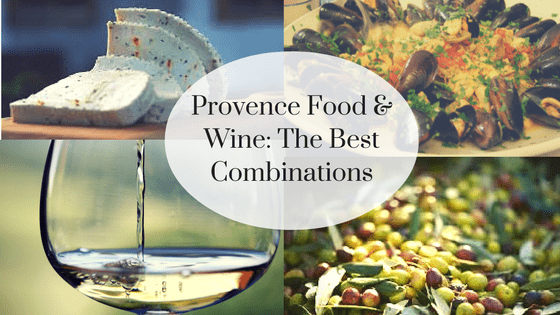What Are the Best Provence Food and Wine Combinations?
|
Tuesday, Jul 11th 2017

Provence Food and Wine: The Best Combinations
How do you match Provence food and wine? What are the key flavors?
Provence has many regional dishes, not just salade nicoise! Here are the best combinations of Provence food and wine.
Stews, Grilled Meats, Fish from Provence
- Beef Stews (Daube)
- These rich, melt-in-your-mouth meat stews, found throughout Provence, have regional variations.
- Tomatoes, olives, herbs, and oranges give added spice.
- In the Rhone Valley, it is often served with rice, especially the nutty, red Camargue rice.
- Serve with a big fruit and spice red wine, such as Cotes du Rhone Villages or Chateauneuf-du-Pape.
- Barbecue (Grillade)
- Both fish and meat, are grilled with herbs such as fennel, rosemary, and thyme. These are common barbecue items.
- The white wine of Cassis–with hints of fennel seed, herbs, and ripe fruit–is a perfect pairing with grilled fish.
- Pans of mussels cooked in their own briny juices need no more than a fresh loaf of bread and a bottle of cold rosé.
- Wild boar (sanglier) is popular. This meat is gamey so try the big meaty reds of Bandol.
- Bouillabaise
- Bouillabaise is actually two dishes in one: a soup and a stew. This dish is a large mixture of fish, flavored with garlic, saffron, and hot cayenne pepper. The soup is served with toast rubbed with garlic, and a spicy sauce called rouille.
- This powerfully flavored dish pairs well with a light and refreshing Grenache-based rosé.
- Aioli and Brandade
- Salt cod is a popular ingredient in both of these offerings. It was introduced to Provence by sailors from Portugal and further north.
- Aioli is a light meal of a poached salt cod steak served with vegetables. The vegetables will vary from season to season. The dish takes its name from the large bowl of garlic mayonnaise that accompanies the fish.
- Brandade is a purée of dried salt cod, olive oil and garlic served with boiled potatoes.
- The powerful flavors pair well with gutsy red wine (Grenache or Syrah) in winter.
- In summer, a full-bodied white, such as those from the Southern Rhone are perfect.
Cheese, Dessert and Olive Oil in Provence
- Cheese
- Most cheeses in Provence are made with goat milk (chevre). Ewe milk cheese (brebis) is also popular. Cow milk cheeses are rarer. The most important thing to consider is the age of the cheese.
- Young goat cheese is soft and creamy with fresh lactic acidity.
- Old cheese is hard and pungent and better for cooking.
- The younger cheese is the flavor of summer. It is eaten with salads, fresh fruit (especially figs) and warm bread. Try with an herby white wine made with Rolle (Vermentino).
- The strong, older cheese is for autumn and winter. Try with a fruity Grenache-based red.
- Bakes
- Tian is a traditional pastry-less quiche style bake. It is made pumpkin (or other vegetables), seasoned with herbs and garlic. Mixed with egg and cheese and a handful of rice (to absorb extra liquid), this is a hearty local dish.
- The combination of sweet pumpkin and salty cheese calls for a rich, oaked white wine.
- Another traditional dish is baked tomatoes, round zucchini, bell peppers, and baby eggplant stuffed with ground beef. Serve these with a full-bodied rosé.
- Olives and Olive Oil
- Cream, butter, and lashings of cheese are rare in Provencal cuisine.
- Olive oil is the go-to ingredient for salads, cooking, and baking. Not all olive oils are the same, however. For a salad, strong olive flavored oils are good with a hint of pepper at the back of the throat. Not just a dressing, but olive oil adds an extra flavor when added to sweet ripe tomatoes and fresh greens.
- For frying, a more neutral oil is suitable.
- For baking bread (fougasse) and cakes, light fruity olive oil gives extra flavor.
- Olives are the essential offering with a glass of wine before dinner.
- Rosé is often served, but try a glass of the aniseed-flavored pastis for something different.
- Desserts
- With so much delicious fruit around in summer, there’s hardly a better dessert.
- Try with a chilled glass of sweet muscat such as Muscat de Beaumes de Venise.
- In winter dried fruits, nuts, nougat, and glacé fruits are traditional.
- The local sweet wine of Christmas is vin cuit, but a tawny port or even Beaumes de Venise offer a similar traditional taste.

